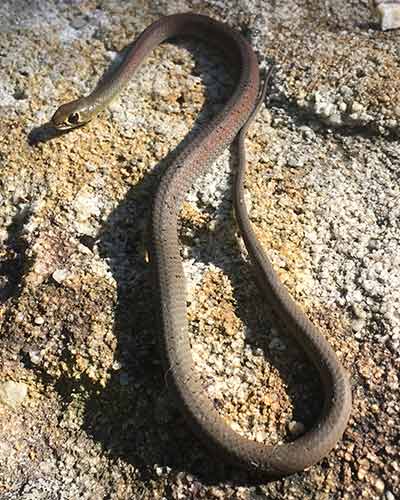Yellow-faced Whip Snake
Snakes of South East Queensland
Yellow-faced Whip Snake
Demansia psammophis
Other common names: Whip Snake, Grass Snake.
Species Profile
Significance to Humans:
Potentially Dangerous
Although often regarded as a mildly venomous species, the Yellow-faced Whip Snake should be considered Potentially Dangerous especially if children or the elderley are involved in a a bite. Venom activity in this species may cause localised pain & severe symptoms. Apply correct first aid and seek medical attention.
General description:
The Yellow-faced Whip Snake ia a very slender snake with long, thin whip-like tail. Large prominent eyes. Colour generally pale olive or bluish-grey, often with rusty flush or longitudinal stripes along front-third of body. Belly grayish-green, often yellowish under tail. Distinctive face markings. Obvious pale cream or yellow rim around eye, with dark comma-shaped marking curving back below eye. Dark bar or line with pale edges runs across front of snout from nostril-to-nostril. Scales smooth. Midbody scales at 15 rows.
Average Length:
Not regarded as a large species the Yellow-faced Whip Snake reaches average length of around 65-70cm, but specimens up to 80cm have been recorded locally.
Habitat in SE Qld:
Dry open areas including open forests, woodlands and grasslands. A frequent species around homes it takes advantage of the high skink numbers associated with urban gardens and dwellings.
General habits:
Primarily a diurnal, active hunter the Yellow-faced Whip Snake has been seen active on hot nights. Not regarded as a climbing species but may occasionally may climb in search or pursuit of potential prey. Quick to retreat most specimens are usually seen disappearing into available cover. When handled they will often flick around quite vigorously. Not generally regarded as a ready biter.
Diet:
The Yellow-faced Whip Snake is a Swift, fast-moving predator of lizards such as skinks. They occasionally take frogs with one record of a juvenile white crowned snake being consumed
Local distribution:
Found throughout most suburbs with the exception of the inner city. To the west recorded as close to the city as Toowong and St Lucia. Likely to occur in closer proximity to the Brisbane city area.
Around the home:
Swift-moving, alert, diurnal snake. Good vision, active hunter. Frequently seen and commonly enters homes during active foraging efforts. Apparently common due to the high densities of favored skink prey. Will utilise a range of ground localities for refugia including constructed rock and sleeper retaining walls, under rocks, sheets of iron, timber piles and other discarded human litter. Nine individuals were captured under one piece of plastic in a Goodna backyard along side an Eastern Brown Snake. Frequent victim of roaming suburban cats.
Photo Gallery
Please be patient while our image gallery loads. If viewing images in the lightbox viewer by clicking on an image, please allow a few second between each image as some images are large to retain their quality and size. Images are loaded straight from Google Photos, if blank spaces appear in gallery please refresh your page.
All image are the property of the website or respected owner and can not be re-used without permission. Copyright applies
